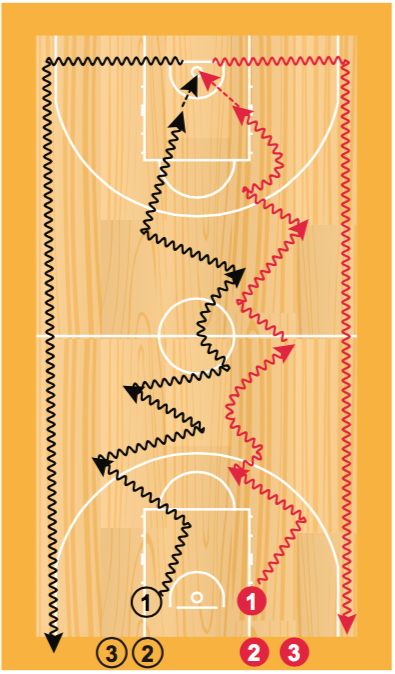Mini Basketball
4.5 Dribbling, passing and shooting
Basketball is a fast-moving and dynamic game and players learning to play need to learn to perform the skills on
the move.
Using activities that involve a range of movement and skills is preferred (and usually more fun) to doing just “single skill” activities. “Single skill” activities may be done first (to remind players of technique) and then progress relatively quickly to a combination activity.
Below are activities that combine various basketball skills.
- Players stay in a designated area of the court (e.g. half court or full court depending on how many players). Some players have a ball and dribble freely in the court. No player may stand still. On the coach’s whistle each player with a ball pass to another player who then dribbles.
- In pairs, one player stands with their legs apart and stretches their arms. Their partner has a ball and is standing 3-4 meters away. On the coach’s signal, the players with the ball starts to dribble, moving under the arms of the standing player and then circles around them to dribble back to their starting point. Here they stop, pivot (front and reverse) and pass the ball to the other stationary player who repeats the activity.
- In pairs, one player has the ball and the other is approximately 3-4 meters away. The player with the ball starts to dribble and stops (in a jump stop) in front of the other and gives a hand-off pass. They should have their hands above and below the ball, so that it is easy for their team mate to grab it. The other Player starts to dribble while the first player walks backward to the starting point and the exercise is repeated.
- In pairs, one player dribbles simultaneously with two balls and on the coach’s signal passes them both to the other player, who dribbles them in turn. The activity may be performed walking and running.
- Relay races where the player dribbles to a predetermined point, jump stops, pivots and passes back to the line (and then jogs to the line). Progress to passing on the run, without stopping and then to passing to the team mate who is on the move.
- “Corner Passing”. Line up the players at the four corners of a half-court, one ball in each corner. At the signal, the first player of each team dribbles to the half- circle, stops, turns, passes the ball to the second in line and runs back. The team which in a set period of time makes the most passes wins.
- The Corner Passing activity can progress to where players do not pass back to their line but pass to the next line (and run to that line). Pivots can be either to the left or right (and forward and back) and passes can be with either hand.
- “Pair Shooting”. One player shoots and the other goes for the rebound and passes the ball out (three shots each, then change). Pairs can compete against each other to be first to reach a certain score.
- Two lines behind the end-line, one player rolls the ball forward and the other runs to retrieve it. Once they have it, they pass to the first player who has entered the court and plays a “give and go”, or “pass and cut” (from right and from left, with the right and the left hand).
- Combination of different types of dribbling, passing and shooting. Teams compete against each other to dribble to the other end, making various dribble moves along the way and scoring a lay-up. Once a player has crossed half way, the next team mate in line starts to dribble. To make the activity more realistic, have players from the opposite team stand on the court so that players are dribbling past them. These players must stand still, but can try to knock the ball away.
